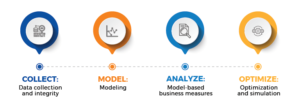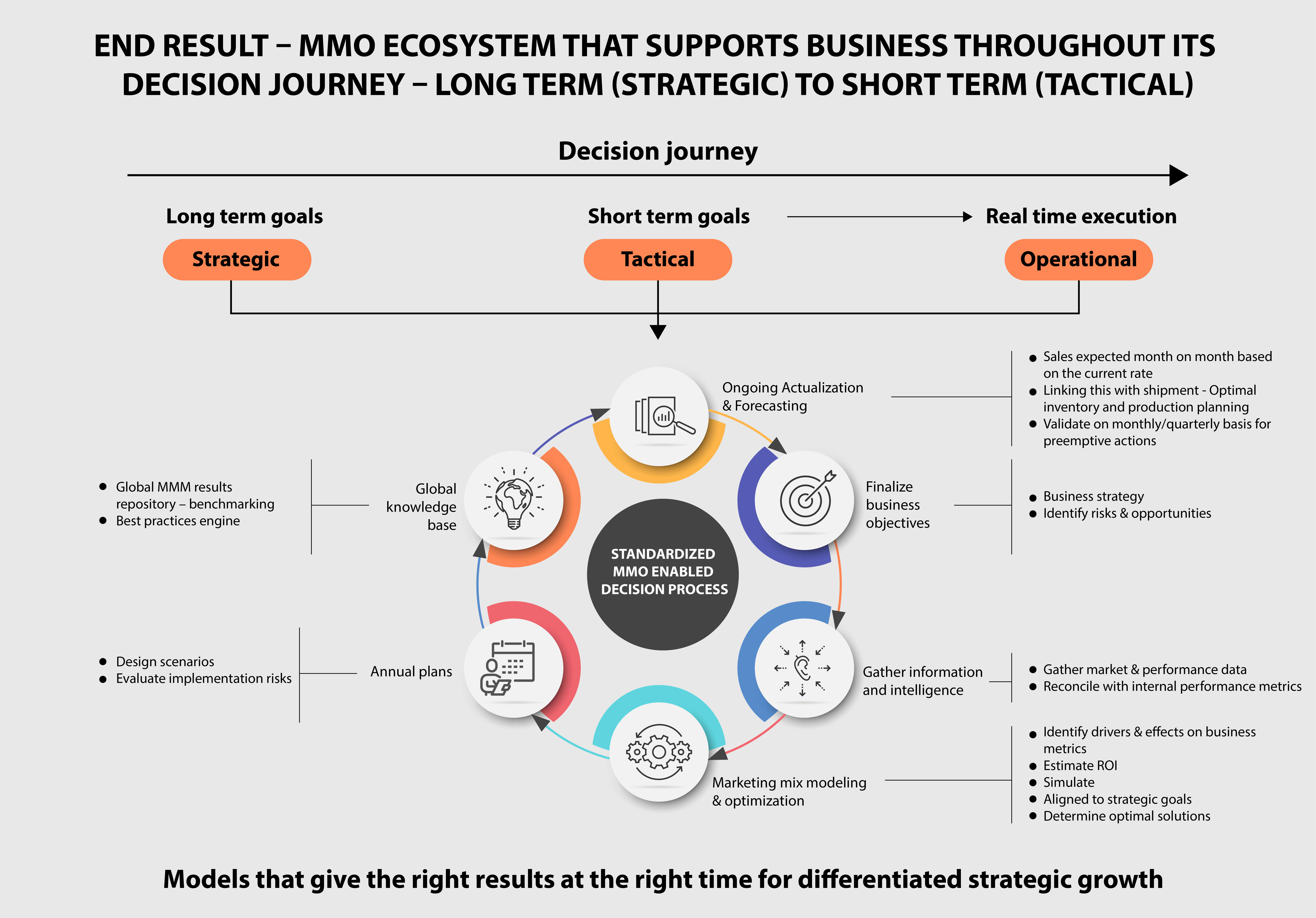Marketing Mix Modeling 101: What, Why, and How to Navigate
Brands spend billions of dollars on advertising and promotional activities every year, making the measurement and optimization of marketing activities a critical pursuit for marketers.
John Wanamaker, one of the pioneers of marketing, was quoted as saying,
Half the money I spend on advertising is wasted; the trouble is I don’t know which half.
Marketing Mix Modeling (MMM) helps businesses to solve the exact problem stated by Wanamaker.
What is Market Mix Modeling?
By definition, Market Mix Modeling (MMM) techniques help measure the impact of marketing activities on sales. The purpose of using MMM is to determine the contribution of each marketing element to sales, and whether the cost incurred is fetching good returns or not (i.e. ROI >=1).
The marketing mix and the 4Ps of marketing are often used as synonyms for one another. In fact, they are not necessarily the same thing.
The 4Ps of marketing is a model for enhancing the components of your “marketing mix” – the way in which you take a new product or service to market. It helps you to define your marketing options in terms of price, product, promotion, and place so that your offering meets a specific customer need or demand.
The four Ps each represent factors to consider when building marketing strategies for optimal impact. They include:
- Product: A product can be either a tangible product or an intangible service that fulfills a specific customer need or demand.
- Price: The amount the customer expects to pay for the product is the price.
- Promotion: Promotion includes advertisements, offers, public relations, and similar marketing communication strategies.
- Place: The place is where a company sells its product and how it distributes the product to the market.
Some of the other factors to consider include customer needs, how the product or service can meet customer needs, how the market recognizes the product or service, how it stands out from the competition, and how the manufacturing company communicates with its customers. Over time as the marketing industry evolved the other Ps that were introduced are: people, processes, and physical evidence.
For marketers and decision-makers, it is also important to know the functioning of marketing mix modeling in the field.
How Does Marketing Mix Modeling Work?
Traditionally marketing mix modeling uses multivariate regression models, in which you have dependent variables (Sales) and independent variables (Base activities, Marketing activities – ATL or BTL, Macro variables, etc.). The dependent variables are regressed against the independent variable or variables (to capture synergies of two or more independent variables) at a time, to see the independent variable’s impact on the dependent variable.
The regression analysis in MMM helps extract key information and insights which enable marketers to determine the ROI of their efforts, and forecast sales using sales uplift. The data helps marketers to assign a numerical value to the impact of media campaigns on sales, achieving their ultimate goals such as optimizing marketing budgets.
But with the diversity in media channels, brands need to understand when and why they should choose a particular marketing measurement strategy. Brands leverage Marketing Mix Modeling (MMM) and/or Multi-Touch Attribution (MTA) to measure the effectiveness of their marketing strategies. Data-driven attribution is a subset of MMM, and the following section has a more detailed breakdown of the difference between the two.
MMM and Data-Driven Attribution
Marketing Mix Modeling and Data-driven Attribution provide crucial and unique business intelligence which help in optimizing marketing campaigns. MMM, for decades, has been helping marketers to optimize campaigns. But with the market environment becoming predominantly digital, marketers felt the need for an attribution model, which would be able to analyze data from every touchpoint and provide detailed insights.
Data-driven attribution provides credit for conversions based on how potential buyers engage with the various ads you promote and influence to convert into your customers. This method credits the data in your account to determine which ads, campaigns, keywords, and tags have the strongest impact on your business goals.
With data-driven attribution, marketers can quickly identify which touchpoints on media drive the most engagement. As a result, those insights are combined with various digital channels to better understand the relationships between channels, the effectiveness of the campaign, and their impact on ROI.
Attribution modeling is a marketing process where rules are set to determine the touchpoints contributing to sales output along the customer journey. This process estimates the revenue contribution of process marketing.
A typical multi-touch attribution model includes the following:
- Linear attribution –
Every touchpoint in the customer journey is trackable and contributes equally to revenue. - Time-decay attribution –
The latest touchpoints in the customer journey contribute more revenue than earlier touchpoints. - Position-based attribution –
Touchpoints at the beginning and end of the customer journey contribute more to revenue than the rest of the touchpoints.
On the other hand, MMM insights are gathered and referenced as part of quarterly or even annual strategic conversations. Traditionally, companies use them for budget planning and strategic purposes. It takes a top-down approach to attribution modeling. Marketers prefer to use both MTA and MMM together, with MMM on the strategic side and MTA on the tactical side, allowing for agility.
The data obtained by MTA and insights on external and seasonal factors help marketers make smarter decisions. For example, deciding that a 20% discount code sent via push notification on a festival deal might be better received.
Building any type of marketing model requires a solid foundation of clean and accurate historical data, an understanding of the challenges to MMM, and how to carry out the phases of MMM.
Challenges of Marketing Mix Modeling
The biggest challenge of MMM is that it is confined to the knowledge of the industry/domain expert or the person running the MMM model. It does not account for unknown variables and variables which were not executed in past by the brand. MMM is descriptive in nature and not prescriptive or predictive based on the traditional approach.
Most think that media mix modeling is ineffective and has no scope in the domain of modern marketing due to fragmented channels. It is because every channel bombards the audience with an overflow of brand messaging, choosing to select only those messages related to their requirements.
Designing an arbitrary ad campaign that doesn’t match the audience’s expectations can reduce ROI on marketing and even distort the brand image in the audience’s eyes. MMM has proven to be an effective technique for a more strategic allocation of funds, but its implementation is critical to achieving optimal results and is not without challenges. The following are some of the challenges to overcome while conducting MMM.
Key Challenges:
- An organization may run multiple campaigns simultaneously. The overlapping touchpoints data might pose a challenge.
- Validation of coefficients with borderline significance is important to maintain the stability and consistency of new data before implementation.
- Modeling and forecasting are more exciting for asymmetric market segments with specific and scarce historical evidence.
- Marketing plans, prioritization, and budgeting are done for all market segments without considering their real-time demand. The allocation must be based on prevailing business or forecast.
- Latency in running the model on historic data and then implementing it for future years.
- Due to high pace environment today, the industry needs a live tool that can churn the MMM result when the activity is taking place.
Conducting Marketing Mix Model
The following are the four phases for effectively conducting the process of Marketing Mix Modeling:
Stage# 1: Collect
Collect data used in statistical models to decide which products will be analyzed. In this phase, marketing mix modeling breaks down business metrics to project product demand and differentiate the contribution between incremental and base drivers.
Marketing strategies separate product sales into two types of sales drivers:
- Incremental Drivers –
These operate on a short-term basis and are indicative of controllable factors implemented by the marketing team. - Base Drivers –
Base drivers include, for example, price, distribution channels, seasonal sales, economic conditions, etc., that lead to base results. They are usually the result of brand equity and reputation built over the years, such as customer loyalty to a business, brand, etc. These are sales achieved without any additional marketing activities.
Stage# 2: Model
MMM uses regression analysis principles to assess the effect of multiple independent variables over a single dependent variable, for example, sales indicators. These variables help plot a chart or draw a regression line. The line illustrates the relationship between the independent variables and the dependent variable.
These techniques are set out to predict future responses depending on response history and suggest possible timelines for the effectiveness of advertising that marketers can use to optimize the marketing mix to compensate for these factors.
Stage# 3: Analyze
In this stage, the selected model’s output is analyzed. One can view these outputs as sales breakdowns, usually in pie charts, with the amount of data reduced for each modeled maneuver. The model-based output is useful for interpreting the campaign through three important metrics:
- Effectiveness
- Efficiency
- Marketing Return of Investment (MROI)
Marketers can access these metrics for the entire marketing effort and each tactic individually.
Stage# 4: Optimize
The final stage of MMM converts outputs into inputs for forecast marketing planning. Here marketers use the analysis results to optimize the marketing mix for their next planning phase.
They will analyze a key part of the optimization in the form of “what if” simulations. Equations showing the relationship between marketing activities and sales results represent the marketing model outputs. These equations help predict what will happen on introducing changes in the marketing mix.
For example, “what if” sellers reduce the product’s price by 5%? This question determines how changes in incremental factors, such as promotional schemes, will affect sales. Your model output will provide an accurate answer, which you can use to create a promotional strategy.
In the market, marketing mix optimization (MMO) is an ideal solution for those with the budget and means to integrate it into their existing analytics ecosystem. It helps enterprises to formulate both short-term and long-term business strategies for maximizing returns.
Marketing Mix Modeling: A Course5 Case Study
Course5 Intelligence offers an integrated AI-powered MMM program, that ingests and analyzes cross-channel campaign data in real time. The solution offers a 360o view of marketing performance, channel sensitivity, media planning, and customer journey. Simulations of marketing scenarios are also forecasted by our Bayesian learning models. These features enable marketers to conduct strategic media planning, adapt quickly to fluctuations, carry out real-time campaign optimization, increase operational efficiency, and maximize ROI.
A leading global CPG company wanted to analyze sales drivers with a focus on marketing spending, in order to make better business decisions. Cours5 conducted a complete marketing mix modeling analysis with marketing expenditure as the focal point. We carried out a deep-dive analysis of sales drivers and considered all the key variables such as price, distribution, media, promotions, and category tested in the model.
We were able to identify the key drivers of growth, along with the difference between base and incremental sales. The elasticity and effectiveness of media activities were also evaluated, determining their contribution to ROI. We were also able to provide the client with the estimated saturation potential and the synergy opportunities for media levers.
Course5 was able to help the client pinpoint the primary sales drivers, transfer media investments to more effective channels, optimize TV airtime, and enhance efficiency.
Given that the Marketing Mix Modeling technique incorporates both internal and external factors into the overall data collection, it provides a much-needed holistic approach to general marketing trends. In this aspect, MMM provides marketers with a 360º view of their potential market situation. Marketing leaders like CMOs are thoughtful about allocating the right budget to their company’s marketing efforts to increase sales.
Get in touch with us and let us figure out how you can optimize your marketing operations and improve your ROI on marketing expenditure.
Don’t miss our next article!
Sign up to get the latest perspectives on analytics, insights, and AI.







